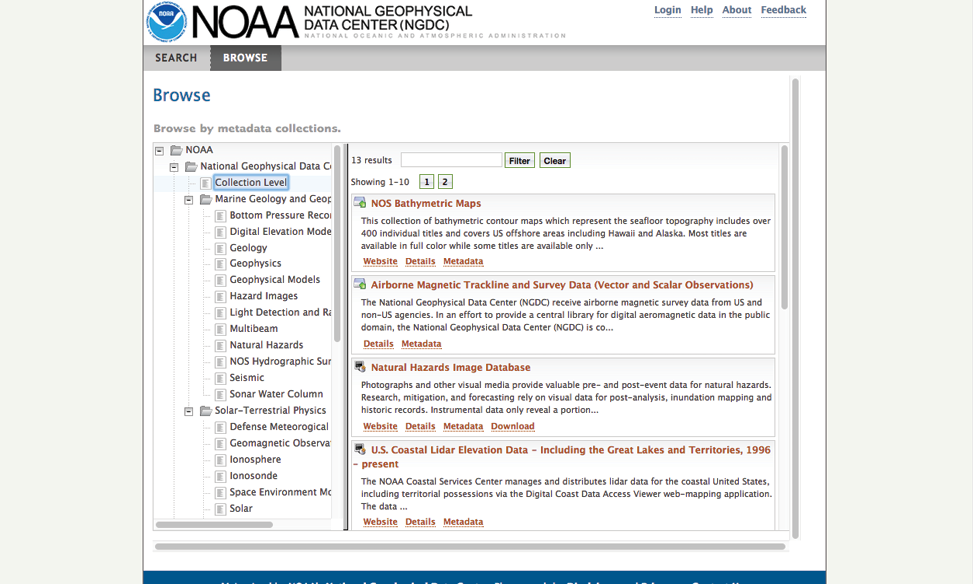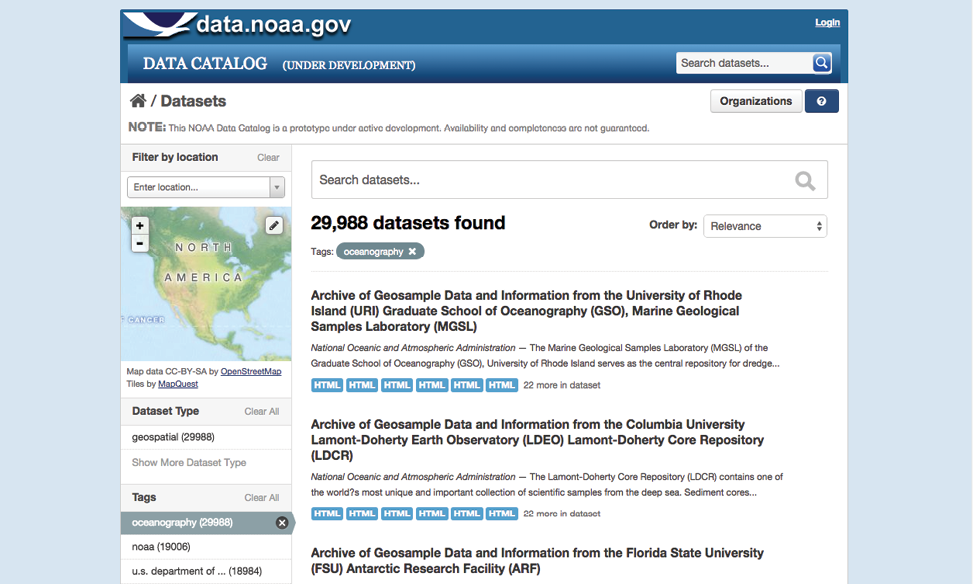The Global Impact of Open Data
United States' NOAA: Opening Up Global Weather Data in Collaboration with Businesses
Creating a New Industry Through Access to Weather Data
by Christina Rogawski, Stefaan Verhulst and Andrew Young*
Reference
2 "A History of NOAA." NOAA History - NOAA Legacy/Agency History/NOAA History. http://www.history.noaa.gov/legacy/noaahistory_1.html
3 "A History of NOAA." NOAA History - NOAA Legacy/Agency History/NOAA History. http://www.history.noaa.gov/legacy/noaahistory_1.html
4 “Assessing the Economic and Social Benefits of NOAA Data.” NAS/OECD Conference. February 2008. http://www.oecd.org/sti/ieconomy/40066192.pdf
5 Chopra, Aneesh P. and Ethan Skolnick. Innovative State: How New Technologies Can Transform Government. (New York, NY: Atlantic Monthly Press), 2014.
6 “Assessing the Economic and Social Benefits of NOAA Data.” NAS/OECD Conference. February 2008. http://www.oecd.org/sti/ieconomy/40066192.pdf
7 “NOAA Looks for Advice to Make Its Data Easier to Use.” Eos, Vol. 95, No. 11. March 18, 2014. http://onlinelibrary.wiley.com/doi/10.1002/2014EO110003/pdf
8 Diaz, Jesus. “How Large Is a Petabyte?” Gizmodo. July 8, 2009. http://gizmodo.com/5309889/how-large-is-a-petabyte
9 Breggin, Linda and Judith Amsalem. “Big Data and Environmental Protection: An Initial Survey of Public and Private Initiatives.” Environmental Law Institute. 2014. https://www.eli.org/sites/default/files/eli-pubs/big-data-and-environmental-protection.pdf
10 Rifkin, Jeremy. “Capitalism is making way for the age of free.” The Guardian. March 31, 2014. http://www.theguardian.com/commentisfree/2014/mar/31/capitalism-age-of-free-internet-of-things-economic-shift
11 GovLab interview with Zachary Goldstein, Chief Information Officer, NOAA, September 3, 2015.
12 GovLab interview with Zachary Goldstein, Chief Information Officer, NOAA, September 3, 2015.
13 GovLab interview with Jeff De La Beaujardiere, Data Management Architect, NOAA, September 18, 2015.
14 GovLab interview with Tim Owen, Chief of Climate Information Services Division, NOAA, July 27, 2015.
15 GovLab interview with Tim Owen, Chief of Climate Information Services Division, NOAA, July 27, 2015.
16 GovLab interview with Tim Owen, Chief of Climate Information Services Division, NOAA, July 27, 2015.
16 “NOAA Issues New Partnership Policy: Response to ‘Fair Weather’ Recommendations Strengthens Relationships Among Government, Universities and the Private Sector.” NOAA Magazine. December 1, 2004. http://www.noaanews.noaa.gov/stories2004/s2348.htm
18 “NOAA Issues New Partnership Policy: Response to ‘Fair Weather’ Recommendations Strengthens Relationships Among Government, Universities and the Private Sector.” NOAA Magazine. December 1, 2004. http://www.noaanews.noaa.gov/stories2004/s2348.htm
19 “NOAA Issues New Partnership Policy: Response to ‘Fair Weather’ Recommendations Strengthens Relationships Among Government, Universities and the Private Sector.” NOAA Magazine. December 1, 2004. http://www.noaanews.noaa.gov/stories2004/s2348.htm
20 “NOAA Issues New Partnership Policy: Response to ‘Fair Weather’ Recommendations Strengthens Relationships Among Government, Universities and the Private Sector.” NOAA Magazine. December 1, 2004. http://www.noaanews.noaa.gov/stories2004/s2348.htm
21 Chopra, Aneesh P. and Ethan Skolnick. Innovative State: How New Technologies Can Transform Government. (New York, NY: Atlantic Monthly Press), 2014.
22 GovLab interview with Tim Owen, Chief of Climate Information Services Division, NOAA, July 27, 2015.
23 GovLab interview with Jeff De La Beaujardiere, Data Management Architect, NOAA, September 18, 2015.
25 “NOAA Looks for Advice to Make Its Data Easier to Use.” Eos, Vol. 95, No. 11. March 18, 2014. http://onlinelibrary.wiley.com/doi/10.1002/2014EO110003/pdf
26 "U.S. Secretary of Commerce Penny Pritzker Delivers Remarks on the Power and Potential of Open Government Data." U.S. Department of Commerce. July 14, 2014. http://www.commerce.gov/news/secretary-speeches/2014/07/us-secretary-commerce-penny-pritzker-delivers-remarks-power-and.
27 GovLab interview with Zachary Goldstein, Chief Information Officer, NOAA, September 3, 2015.
28 GovLab interview with Tim Owen, Chief of Climate Information Services Division, NOAA, July 27, 2015.
30 GovLab interview with Tim Owen, Chief of Climate Information Services Division, NOAA, July 27, 2015.
31 GovLab interview with Zachary Goldstein, Chief Information Officer, NOAA, September 3, 2015.
32 “Google’s Participation in the Climate Data Initiative.” https://docs.google.com/document/d/15BH83pdO0-hY-vnznLxCU6mH9sZ_8mkSZHBIJsOPqU4/pub.
33 “Surging Seas.” Surging Seas: Sea Level Rise Analysis by Climate Central. http://sealevel.climatecentral.org/.
34 “Creating a Climate-Resilient Planet with Maps, Apps, and Data.” ArcWatch: GIS News, Views, and Insights. April 1, 2014. http://www.esri.com/esri-news/arcwatch/0414/creating-a-climate-resilient-planet-with-apps-maps-and-data
35 “Creating a Climate-Resilient Planet with Maps, Apps, and Data.” ArcWatch: GIS News, Views, and Insights. April 1, 2014. http://www.esri.com/esri-news/arcwatch/0414/creating-a-climate-resilient-planet-with-apps-maps-and-data
36 “FACT SHEET: The President’s Climate Data Initiative: Empowering America’s Communities To Prepare For The Effects Of Climate Change.” The White House, 2014. http://www.whitehouse.gov/the-press-office/2014/03/19/fact-sheet-president-s-climate-data-initiative-empowering-america-s-comm.
37 GovLab interview with Tim Owen, Chief of Climate Information Services Division, NOAA, July 27, 2015.
38 GovLab interview with Tim Owen, Chief of Climate Information Services Division, NOAA, July 27, 2015.
39 “Value of a Weather Ready Nation.” NOAA. October 13, 2011. http://www.ppi.noaa.gov/wp-content/uploads/PPI-Weather-Econ-Stats-10-13-11.pdf
40 Adams, R.M., C.C. Chen, B.A. McCarl, and R.W. Weiher, “The economic consequences of ENSO events for agriculture,” Climate Research, 13 (December 10, 1999). Available at: http://www.int-res.com/articles/cr/13/c013p165.pdf
41 “Value of a Weather Ready Nation.” NOAA. October 13, 2011. http://www.ppi.noaa.gov/wp-content/uploads/PPI-Weather-Econ-Stats-10-13-11.pdf
42 Weiher, Rodney. “Assessing the Economic & Social Benefits of NOAA Data.” NOAA. February 2008. http://www.oecd.org/sti/ieconomy/40066192.pdf
43 “Value of a Weather Ready Nation.” NOAA. October 13, 2011. http://www.ppi.noaa.gov/wp-content/uploads/PPI-Weather-Econ-Stats-10-13-11.pdf
44 "The Economic Value of Resilient Coastal Communities." NOAA. March 18, 2013. http://www.ppi.noaa.gov/wp-content/uploads/EconomicValueofResilientCoastalCommunities.pdf.
46 “Value of a Weather Ready Nation.” NOAA. October 13, 2011. http://www.ppi.noaa.gov/wp-content/uploads/PPI-Weather-Econ-Stats-10-13-11.pdf
47 Teisberg, T., R. Weiher, and A. Khotanzad. “The Economic Value of Temperature Forecasts in Electricity Generation.” Bulletin of the American Meteorological Society, Vol. 86, No. 12. December, 2005. http://journals.ametsoc.org/doi/pdf/10.1175/BAMS-86-12-1765
48 Lazo, Jeffrey K., Rebecca E. Morss, and Julie L. Demuth. “300 Billion Served: Sources, Perceptions, Uses, and Values of Weather Forecasts.” Bulletin of the American Meteorological Society, Vol. 90. June 2009. http://journals.ametsoc.org/doi/pdf/10.1175/2008BAMS2604.1
49 Lazo, Jeffrey K., Rebecca E. Morss, and Julie L. Demuth. “300 Billion Served: Sources, Perceptions, Uses, and Values of Weather Forecasts.” Bulletin of the American Meteorological Society, Vol. 90. June 2009. http://journals.ametsoc.org/doi/pdf/10.1175/2008BAMS2604.1
50 "Government Data Could Unleash Economic Growth, Expert Says," Government Technology. December 11, 2014. http://www.govtech.com/data/Government-Data-Could-Unleash-Economic-Growth-Expert-Says.html.
51 Upbin, Bruce. “Monsanto Buys Climate Corp for $930 Million.” Forbes. October 2, 2013. http://www.forbes.com/sites/bruceupbin/2013/10/02/monsanto-buys-climate-corp-for-930-million/
52 Lazo, J.K., D.M. Waldman, B.H. Morrow, and J.A. Thacher. “Assessment of Household Evacuation Decision Making and the Benefits of Improved Hurricane Forecasting.” Weather and Forecasting, Vol. 25, No. 1. February, 2010. http://journals.ametsoc.org/doi/pdf/10.1175/2009WAF2222310.1
53 “U.S. Secretary of Commerce Penny Pritzker Delivers Remarks on the Power and Potential of Open Government Data.” 2014 Esri International User’s Conference, July 14, 2014. http://www.commerce.gov/news/secretary-speeches/2014/07/us-secretary-commerce-penny-pritzker-delivers-remarks-power-and
54 “Stories from the Field.” Digital Coast, Office for Coastal Management, NOAA. http://coast.noaa.gov/digitalcoast/stories/list
55 “Assessing Fire Hazard Risk in Southern California.” Digital Coast, Office for Coastal Management, NOAA. http://coast.noaa.gov/digitalcoast/stories/californiafire
56 "Harmful Algal Blooms Observing System – HABSOS," NOAA: Harmful Algal Blooms Observing System. http://habsos.noaa.gov/.
57 GovLab interview with Maria Patterson, Scientific Lead, Open Science Data Cloud, University of Chicago, Open Cloud Consortium, October 1, 2015.
58 GovLab interview with Jeff De La Beaujardiere, Data Management Architect, NOAA, September 18, 2015.
59 GovLab interview with Tim Owen, Chief of Climate Information Services Division, NOAA, July 27, 2015.
60 GovLab interview with Maria Patterson, Scientific Lead, Open Science Data Cloud, University of Chicago, Open Cloud Consortium, October 1, 2015.
61 GovLab interview with Allison Soussi-Tanani, Digital Strategy Lead and Web Committee Co-Chair, NOAA, September 16, 2015.
62 GovLab interview with Allison Soussi-Tanani, Digital Strategy Lead and Web Committee Co-Chair, NOAA, September 16, 2015.
63 GovLab interview with Allison Soussi-Tanani, Digital Strategy Lead and Web Committee Co-Chair, NOAA, September 16, 2015.
64 GovLab interview with Tim Owen, Chief of Climate Information Services Division, NOAA, July 27, 2015.
65 GovLab interview with Jeff De La Beaujardiere, Data Management Architect, NOAA, September 18, 2015.
67 GovLab interview with Allison Soussi-Tanani, Digital Strategy Lead and Web Committee Co-Chair, NOAA, September 16, 2015.
68 “U.S. Secretary of Commerce Penny Pritzker Delivers Remarks on the Power and Potential of Open Government Data.” U.S. Department of Commerce. July 14, 2014. http://www.commerce.gov/news/secretary-speeches/2014/07/us-secretary-commerce-penny-pritzker-delivers-remarks-power-and.
70 “NOAA announces RFI to unleash power of ‘big data.’” NOAA. February 24, 2014. http://www.noaanews.noaa.gov/stories2014/20140224_bigdata.html.
71 “NOAA Looks for Advice to Make Its Data Easier to Use.” Eos, Vol. 95, No. 11. March 18, 2014. http://onlinelibrary.wiley.com/doi/10.1002/2014EO110003/pdf
72 “NOAA asks industry to fund open data program.” Federal Times. November 18, 2014. http://www.federaltimes.com/article/20141114/FEDIT03/311140011/NOAA-asks-industry-fund-open-data-program
73 GovLab interview with Tim Owen, Chief of Climate Information Services Division, NOAA, July 27, 2015.
74 GovLab interview with Zachary Goldstein, Chief Information Officer, NOAA, September 3, 2015.
75 GovLab interview with Maria Patterson, Scientific Lead, Open Science Data Cloud, University of Chicago, Open Cloud Consortium, October 1, 2015.
76 GovLab interview with Zachary Goldstein, Chief Information Officer, NOAA, September 3, 2015.
77 GovLab interview with Maria Patterson, Scientific Lead, Open Science Data Cloud, University of Chicago, Open Cloud Consortium, October 1, 2015.
78 GovLab interview with Zachary Goldstein, Chief Information Officer, NOAA, September 3, 2015.
79 GovLab interview with Maria Patterson, Scientific Lead, Open Science Data Cloud, University of Chicago, Open Cloud Consortium, October 1, 2015.
80 GovLab interview with Maria Patterson, Scientific Lead, Open Science Data Cloud, University of Chicago, Open Cloud Consortium, October 1, 2015.
81 GovLab interview with Zachary Goldstein, Chief Information Officer, NOAA, September 3, 2015.




